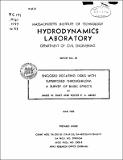Enclosed Rotating Disks with Superposed Throughflow: A Survey of Basic Effects
Author(s)
Daily, James W.; Arndt, Roger E. A.
Download04305991.pdf (4.940Mb)
Metadata
Show full item recordAbstract
A qualitative study was made of the flow field induced by an enclosed rotating disk with a radially outward throughflow superposed using air as the test fluid. The purpose of this survey is a determination of the range of variables at which important phenomena occur so that a quantitative study of surface resistance, pressure and velocity distribution and other observed phenomena such as unsteadiness, boundary layer separation and stall may be made. Disks of 18-1/8 inches diameter enclosed in a housing in which axial spacing could be varied from 1/8 inch to 2-1/8 inches were used in this study. Througflow was admitted in the axial direction at the front and rear of the disk housing in such a way as to make the flow on both sides of the disk as symmetrical as possible. Flow visualization was made possible using smoke injected at various points. Stroboscopic photography aided the visual observations of the flow field. Transition to turbulence was observed to be a function of the local Reynolds number ... and the axial spacing. It was observed that the torque was increased by throughflow over the corresponding value without throughflow. A systematic change in the pressure field was observed with increasing amounts of throughflow. Of particular interest is the observation under certain conditions of large periodic fluctuations, the frequency of which is related to the rotational speed, and the amount of throughflow.
Description
Scanning notes: p.B-5 is an oversized foldout scanned via the Bookeye. Prepared under Army Research Office (Durham) grant nos. DA-ORD-31-124-61-G5 DA-ORD-31-124-G131 DA Proj. No. 59901004 AROD Proj. 2500-E
Date issued
1962-06Publisher
Cambridge, Mass. : Dept. of Civil Engineering, Massachusetts Institute of Technology
Other identifiers
53
Series/Report no.
R (Massachusetts Institute of Technology. Department of Civil Engineering) ; 62-21.Report (Massachusetts Institute of Technology. Hydrodynamics Laboratory) ; no. 53.